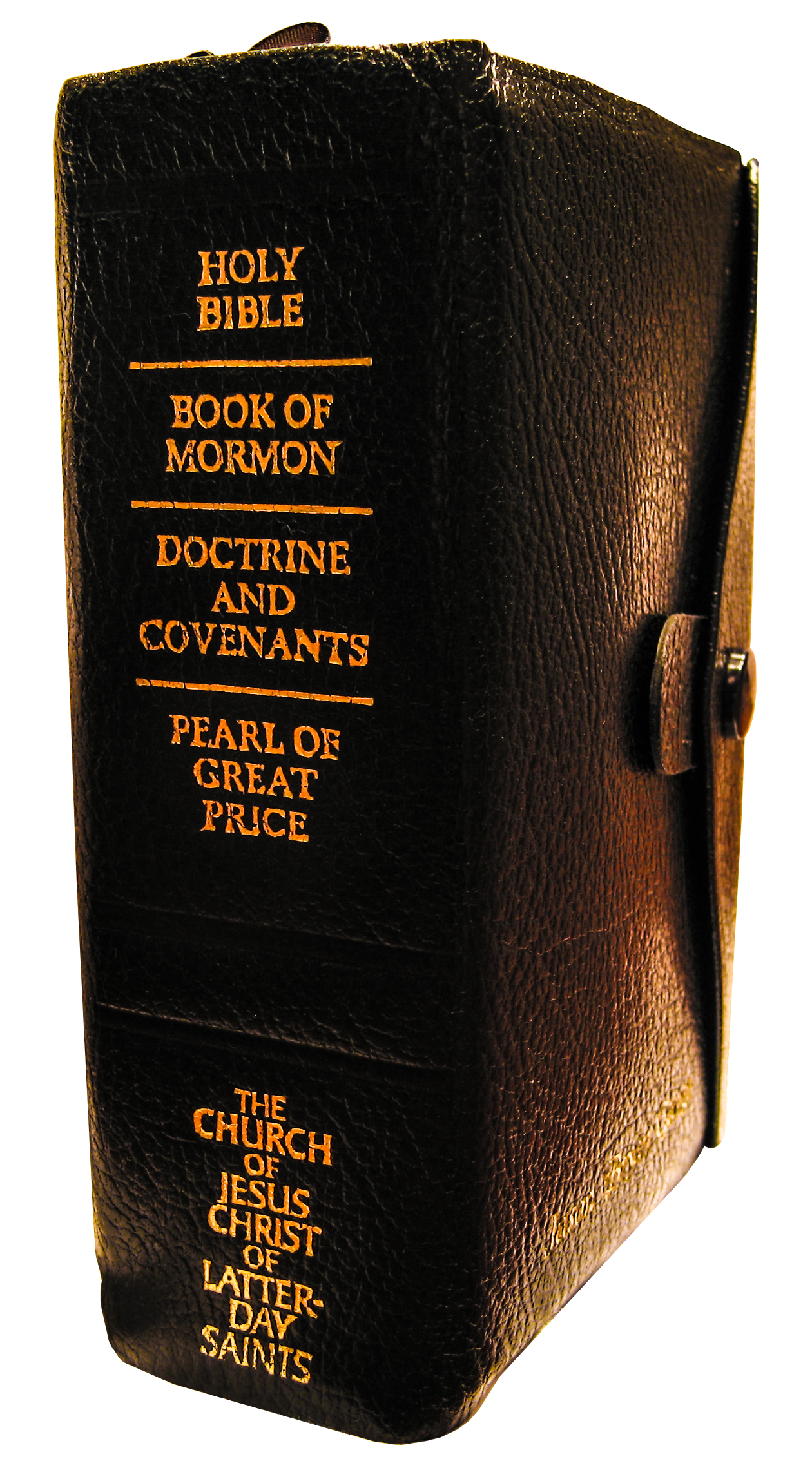This
volume contains the three standard works of the Church of Jesus Christ of
Latter Day Saints, otherwise known as the LDS Church or the Mormon Church.
Most people have heard about the Book of Mormon, published in 1830 by Joseph Smith, the founder of the Mormon Church. It's supposedly a translation of an ancient document engraved on golden plates, a document which Smith claimed to have found at Hill Cumorah in Upstate New York. Nobody has seen the original, except eleven supporters of Smith known as the Three Witnesses and the Eight Witnesses. The story of how the Book of Mormon was found and translated has overt supernatural elements, and must be considered bogus. In reality, Smith wrote the book all by himself. Still, it's a relatively interesting read.
The Book of Mormon is a kind of "alternative Bible". The plot is set in pre-Columbian America, and the main protagonists are the White, fair and godly Nephites and the dark-skinned, sinful and cursed Lamanites. Both are of Israelite stock. Eventually, Jesus Christ himself appears in America and creates a church, uniting both Nephites and Lamanites. However, the people eventually split again, and in a final battle the Lamanites exterminate the Nephites. The last Nephite, Moroni, hides the gold plates at Cumorah, where Joseph Smith finds them centuries later.
Of course, there is absolutely no evidence of this story. The Lamanites are supposedly the ancestors of the American Indians, but genetic tests reveal no Semitic genes among them. Nor have archaeologists discovered an advanced White Israelite civilization anywhere in America. Joseph Smith simply reworked the Biblical stories and gave them a more intriguing American setting. Indeed, that's probably the entire point: to claim that modern United States is somehow God's chosen nation, and has a "Biblical" prehistory similar to that of ancient Israel. The Book of Mormon also "clarifies" the Bible on many obscure points, "solving" various theological conflicts between Protestant denominations current during Joseph Smith's own lifetime. And yet, he wanted his readers to believe that this was an ancient document, written in "reformed Egyptian", no less!
Had Mormonism simply been a religion centred on the Book of Mormon, it would probably have been just one out of many Protestant denominations. However, Mormonism continued evolving after Smith had published the book, becoming more and more exotic and deviant in the process. This can be seen in the two additional scriptures included in this volume, "Doctrine and Covenants" and "The Pearl of Great Price".
"Doctrine and Covenants" is tedious and boring, and contains divine revelations supposedly given to Joseph Smith and some of his successors. Most of these deal with administrative issues concerning the organization of various priesthoods. However, there is also a revelation allowing polygamy. Ironically, the Book of Mormon explicitly prohibits polygamy, but when Smith got other ideas about it, he simply overruled the supposed sacred writ by a new revelation! (Later, the LDS Church stopped practicing polygamy, after decades of persecution by the US authorities.)
But the most sensational of the standard works is surely "The Pearl of Great Price". It contains two main items, known as the Book of Moses and the Book of Abraham. Of these, the Book of Abraham is the most controversial. For starters, it's polytheist! The scripture claims that the world was created by the gods (in plural). It also claims that the otherwise unknown planet Kolob is the centre of the universe, and that the gods who created Earth reside and assemble on this planet. This strange blend of paganism and science fiction is enough to drive main-line Christians quite mad, while atheists presumably use it to ridicule the Mormon true believers. (And yes, there is an actual science fiction series based on these notions.)
Joseph Smith claimed that the Book of Abraham was an actual Egyptian document. Apparently, Smith *did* have a genuine papyrus document at his disposal, probably bought from a travelling party. Unfortunately, this time he made the mistake of publishing the document. At the time, nobody could read Egyptian hieroglyphs. Today, we know that the document is simply a part of the Egyptian Book of the Dead! It doesn't mention Abraham, Kolob or the Mormon gods.
The Book of Moses, curiously, say that God (in the singular) created heavens and the earth. However, it also claims that God created an infinity of inhabited planets, a notion unacceptable to Protestant fundamentalists. Otherwise, the Book of Moses contains innovative stories about Adam, Cain and Enoch. The text is also included in "The Inspired Version of the Bible", a new Bible "translation" written by Joseph Smith, where he simply revised those portions he saw fit, claiming divine inspiration. While "The Inspired Version" has never been officially canonized by the LDS Church, some other portions of it are also included in the Pearl of Great Price.
Finally, it should be noted that many other aspects of the Mormon religion aren't mentioned in the standard works. For instance, the Mormon "endowment" is a secret ritual (consult any anti-Mormon pamphlet for a detailed description). Mormonism has continued changing since Joseph Smith's untimely death, and it's not always clear which teachings are official.
Still, everyone interested in the religious message of the LDS Church must start with the standard scriptures. Personally, I'm convinced that Joseph Smith was a conscious fraud, but one cannot deny that his religious imagination was quite outstanding!
Written in 2009 during my skeptical period. Hence the attacks on Joseph Smith as a "fraud", etc.

No comments:
Post a Comment